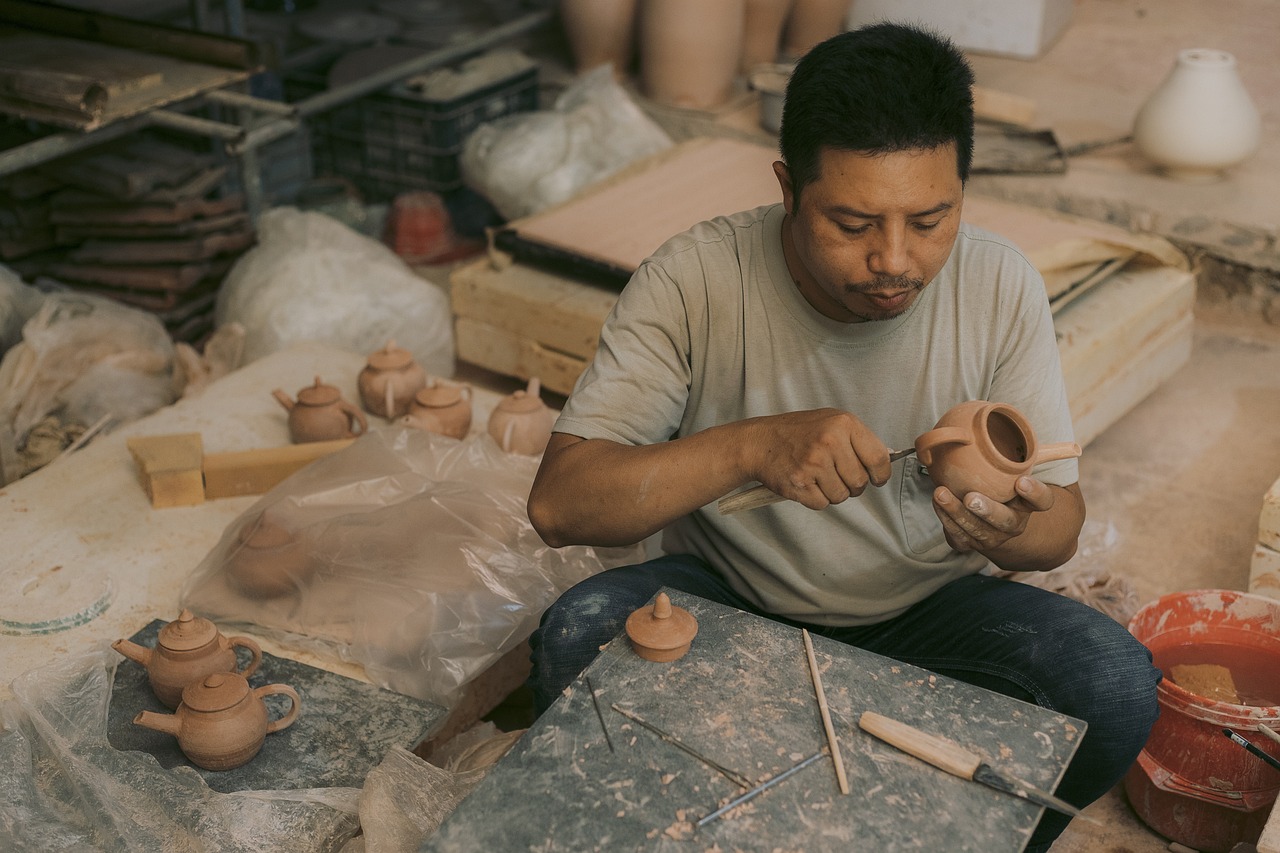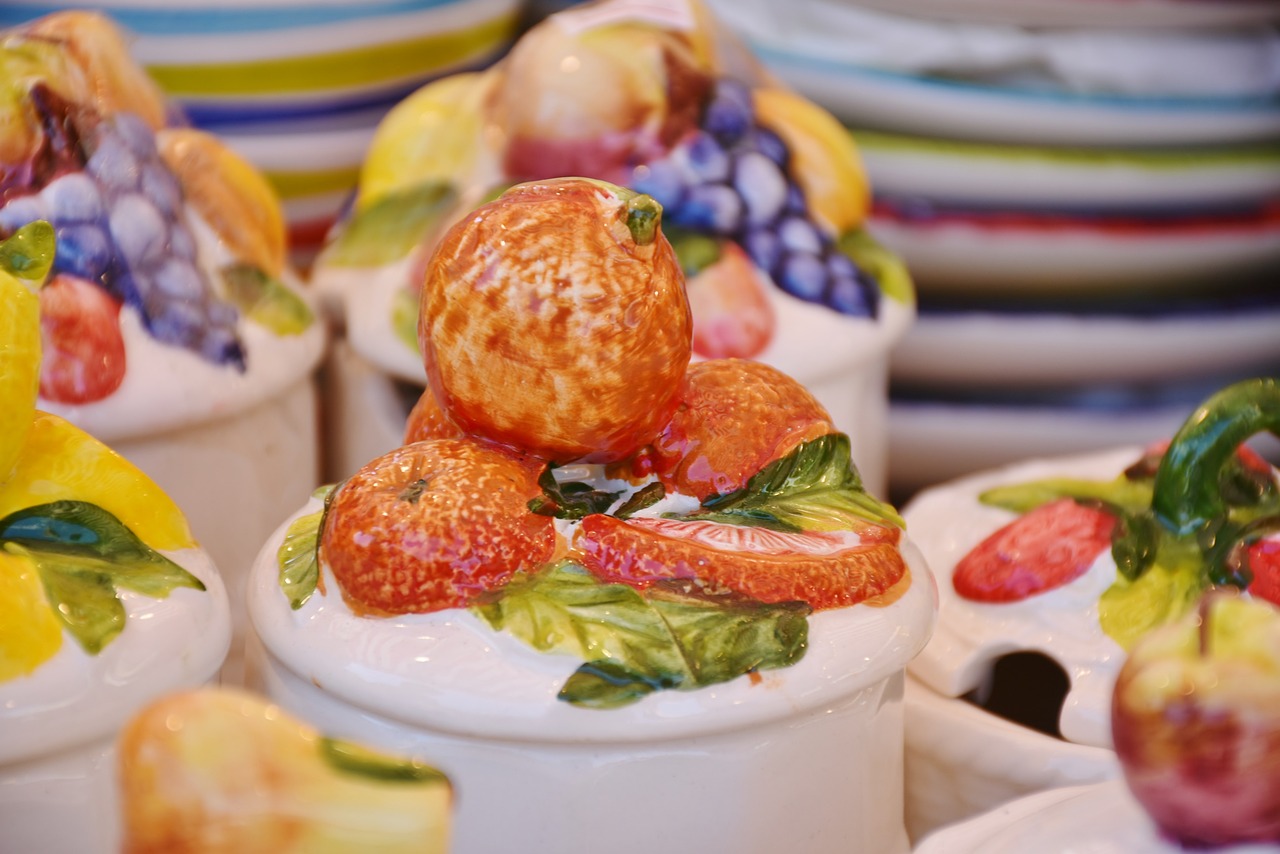Simple Ceramics Projects to Enhance Your Skills
Welcome to the world of ceramics, where creativity meets craftsmanship! If you're looking to enhance your skills and dive into some exciting projects, you've landed in the right place. Whether you're a complete novice or an experienced artisan, this article is packed with inspiring ideas that will challenge your abilities and ignite your passion for clay. Ceramics is not just about molding and shaping; it’s an opportunity to express your personality and style through your creations. So, roll up your sleeves, grab some clay, and let’s get started on this artistic journey!
Before you jump into your first project, it’s crucial to understand the basics of clay types and the tools you'll need. There are several types of clay, each with unique properties that affect your work. For beginners, earthenware is a great choice due to its forgiving nature and vibrant colors. Stoneware is another popular option, known for its durability and versatility. When it comes to tools, a few essential items will make your life much easier:
- Pottery Wheel: If you're interested in throwing clay, a pottery wheel is essential.
- Rolling Pin: Perfect for flattening clay for hand-building projects.
- Clay Cutters: Useful for shaping and trimming your pieces.
- Sculpting Tools: These help in adding details and textures.
By familiarizing yourself with these materials and tools, you'll set a strong foundation for your ceramics projects. Remember, practice makes perfect, and every piece you create is a step towards mastering your craft!
Hand-building is one of the most fundamental techniques in ceramics, and it offers a fantastic way to create unique pieces without the need for a wheel. This section will introduce you to various methods like pinch pots, coil building, and slab construction. Each of these techniques allows you to express your creativity and develop your skills in different ways.
Pinch pots are simple yet versatile creations that are perfect for beginners. The process is straightforward: start by taking a ball of clay, then use your fingers to pinch and shape it into a small bowl or container. This technique not only helps you learn how to manipulate clay but also encourages you to explore your artistic side. With pinch pots, the possibilities are endless!
Once you've mastered the basic shape, it's time to get creative! Personalizing your pinch pots can be a fun way to add your flair. Consider incorporating textures and patterns by:
- Using stamps or tools to create impressions.
- Adding coils or small pieces of clay for decorative elements.
- Experimenting with carving designs into the surface.
These enhancements can elevate your pinch pots from simple to stunning, making them truly one-of-a-kind pieces of art.
Did you know that your pinch pots can also serve a practical purpose? Transform them into functional items like small planters or catchalls for keys and coins. These practical applications not only make your creations useful but also encourage you to think about how your art can fit into everyday life.
If you're ready to take on a more complex challenge, coil building is the way to go! This technique involves stacking coils of clay to construct larger forms, such as vases, pots, or even sculptures. The beauty of coil building lies in its flexibility; you can create anything from simple shapes to intricate designs. Start by rolling out long, even coils, and then stack and blend them together to form your desired shape. The key is to ensure that each coil is securely attached to the one below it!
After you’ve shaped and dried your pieces, it’s time to add some color and personality through glazing. Glazing is an essential part of ceramics that not only enhances the visual appeal but also adds a protective layer to your work. There are various glazing techniques you can explore, including dipping, brushing, and spraying. Each method offers a different finish, allowing you to create unique looks for your pieces.
Selecting the appropriate glaze can significantly affect the final appearance of your work. When choosing glazes, consider the following:
- The type of clay body you are using.
- The firing temperature of your kiln.
- The desired finish—glossy, matte, or textured.
By thoughtfully selecting your glazes, you can enhance the beauty of your creations and ensure they stand out!
Different application methods can yield varied results, so don’t be afraid to experiment! Techniques such as layering and blending can create stunning effects in your ceramics. For instance, try dipping one piece in a colored glaze and brushing another with a contrasting shade to see how they interact. The beauty of glazing lies in its unpredictability, so embrace the surprises and let your creativity shine!
Q: What type of clay is best for beginners?
A: Earthenware is often recommended for beginners due to its ease of use and vibrant color options.
Q: How do I know when my clay is dry enough to fire?
A: Your clay should be bone dry, meaning it feels cool to the touch and no longer feels damp.
Q: Can I use regular paint on my ceramics?
A: No, regular paint is not suitable for ceramics. Always use glazes designed for high temperatures in kilns.

Getting Started with Clay
Getting started with clay can feel a bit like stepping into a new world filled with endless possibilities. Imagine a soft, malleable substance that can transform into anything your imagination can conjure—it's both exhilarating and a tad intimidating! Before diving headfirst into your first ceramics project, it’s crucial to understand the basics of clay types and the essential tools you'll need. This foundational knowledge will not only set you up for success but also enhance your overall experience as you mold and shape your creations.
First off, let's talk about the different types of clay. Each type has its unique properties and uses, which can significantly affect your projects. Here are the most common types you might encounter:
- Earthenware: This is a low-fire clay that is easy to work with and perfect for beginners. It’s porous and often used for decorative pieces.
- Stoneware: A mid-range clay that is more durable and less porous than earthenware. It’s great for functional items like dishes and mugs.
- Porcelain: Known for its fine texture and translucence, porcelain is a high-fire clay that can be challenging but rewarding for more advanced projects.
Now that you have a basic understanding of clay types, let’s move on to the tools you’ll need. Having the right tools can make your crafting experience smoother and more enjoyable. Here’s a quick rundown of essential tools:
| Tool | Purpose |
|---|---|
| Clay Knife | For cutting and shaping the clay. |
| Rolling Pin | To flatten the clay for slab construction. |
| Sponge | For smoothing surfaces and adding moisture. |
| Wire Cutter | To slice off pieces of clay from larger blocks. |
| Pottery Wheel | For throwing pottery (optional for beginners). |
Once you have your clay and tools ready, it’s time to get your hands dirty! Start by kneading the clay to remove air bubbles and ensure a consistent texture. This step is vital because trapped air can cause your pieces to crack during firing. Think of it like preparing dough for baking; the more you work it, the better the outcome!
As you embark on your ceramics journey, don’t be afraid to experiment. Each piece you create will teach you something new, whether it’s about the clay itself, your techniques, or your artistic vision. Remember, the beauty of working with clay lies in its imperfections. Each crack and uneven edge tells a story of your creative process. So, embrace the mess, and let your imagination run wild!
In conclusion, starting with clay can be an incredibly rewarding experience. By understanding the different types of clay and having the right tools at your disposal, you’ll be well on your way to creating beautiful, handcrafted pieces. So, roll up your sleeves and let the adventure begin!
Q1: What type of clay is best for beginners?
A1: Earthenware is often recommended for beginners due to its ease of use and low firing temperature.
Q2: Do I need a pottery wheel to start working with clay?
A2: No, you can begin with hand-building techniques, which are perfect for beginners and allow for more creative freedom.
Q3: How do I prevent my clay from drying out?
A3: Keep your clay covered with a damp cloth or plastic wrap when you’re not using it to maintain moisture.
Q4: Can I use regular paint for decorating my clay pieces?
A4: It's best to use glazes specifically designed for ceramics, as regular paint may not withstand firing and could be harmful.

Hand-Building Techniques
Hand-building is a fundamental aspect of ceramics that allows artists to express their creativity without the need for a potter's wheel. This technique is perfect for beginners and seasoned potters alike, as it opens up a world of possibilities for creating unique and personalized pieces. Whether you're looking to craft simple bowls or intricate sculptures, hand-building techniques provide the foundation for your artistic journey. The three primary methods of hand-building include pinch pots, coil building, and slab construction. Each method has its own charm and offers different challenges and rewards.
Pinch pots are one of the easiest ways to start your hand-building adventure. They require minimal tools—just your hands and a bit of imagination! You begin by taking a ball of clay and using your fingers to pinch and shape it into a small bowl or container. This method is not only straightforward but also allows you to develop a feel for the clay, which is essential for more advanced techniques. As you become comfortable with pinching, you can experiment with different shapes and sizes, creating everything from tiny trinket holders to larger serving bowls.
Once you've mastered pinch pots, you might want to explore coil building. This technique involves rolling out long, snake-like coils of clay and stacking them on top of each other to form larger and more complex structures. It's akin to building a tower with blocks, where each coil adds height and dimension to your creation. The beauty of coil building lies in its versatility; you can create vases, pots, and even sculptural forms. To achieve a seamless look, it's crucial to blend the coils together, ensuring that your piece is not only aesthetically pleasing but also structurally sound.
Another exciting aspect of hand-building is slab construction. This technique involves rolling out flat sheets of clay and cutting them into shapes that can be assembled to create boxes, plates, or other flat forms. Think of it as crafting with paper, where you can cut and fold your way to a beautiful creation. Slab construction allows for intricate designs and patterns, giving you the freedom to explore your artistic vision. You can even incorporate textures or add decorative elements like handles or lids to make your pieces truly one-of-a-kind.
As you dive deeper into hand-building, it's essential to remember that the key to success is practice and exploration. Don't be afraid to experiment with different techniques, shapes, and textures. Each piece you create is a stepping stone toward mastering your craft. And while the process may sometimes be messy, the joy of working with clay is worth every moment. So grab your tools, unleash your creativity, and let your hands do the talking!
- What type of clay is best for hand-building?
Earthenware, stoneware, and porcelain are all great options for hand-building. Each type has its unique characteristics, so it's worth experimenting to see which one you prefer.
- Do I need special tools for hand-building?
No special tools are required, but having a few basic items like a rolling pin, knife, and sponge can be helpful.
- How do I prevent my clay from drying out?
Keep your clay covered with a damp cloth or plastic wrap when you're not using it to maintain moisture.
- Can I combine different hand-building techniques?
Absolutely! Many artists blend techniques to create unique pieces, so feel free to mix pinch pots, coils, and slabs in your projects.

Pinch Pots
Pinch pots are one of the most accessible and enjoyable ways to dive into the world of ceramics. They are not just simple clay shapes; they are a canvas for your creativity and a great way to practice your skills. The beauty of pinch pots lies in their versatility—you can create anything from small bowls to decorative containers, all with just your hands and a lump of clay. So, how do you get started?
To make a pinch pot, you first take a small ball of clay, about the size of a golf ball. Begin by rolling it into a smooth sphere. Once you have your sphere, press your thumb gently into the center, creating a small indentation. This is where the fun begins! As you pinch the walls of the pot with your fingers, you can shape it into whatever form you desire. The key is to keep the walls even, so try to maintain a consistent thickness throughout. If you find yourself with a thicker area, don’t worry; just take a moment to smooth it out.
One of the most exciting aspects of pinch pots is the opportunity to personalize your creations. You can add textures, patterns, and even incorporate other materials to make your pots truly unique. For instance, consider using natural objects like leaves or fabric to press into the clay, leaving behind an imprint that adds character. You can also use tools like forks or stamps to create intricate designs. The possibilities are endless!
Now, let’s talk about the functional uses of your pinch pots. They’re not just pretty to look at; they can serve a variety of practical purposes. Here are a few ideas:
- Small Planters: Create a lovely home for your succulents or herbs.
- Catchalls: Use them to hold keys, coins, or other small items.
- Gift Items: Fill them with treats or small gifts for a personal touch.
As you experiment with pinch pots, remember that the journey of creation is just as important as the final product. Embrace the imperfections and learn from each piece you make. With practice, you’ll develop a unique style that reflects your personality and artistic vision. So grab some clay, let your fingers do the talking, and start creating your very own pinch pots!

Creating Unique Designs
When it comes to ceramics, one of the most exciting aspects is the opportunity to personalize your creations. Your pinch pots can become a canvas for your imagination, allowing you to express your unique style. But how do you transform a simple bowl into a stunning piece of art? The answer lies in the details! Adding textures and patterns can elevate your work from ordinary to extraordinary. You might wonder, "What are some effective ways to add these unique touches?" Let's dive into some creative techniques.
First off, consider using tools and natural elements to create texture. You can press leaves, lace, or even fabric onto the surface of the clay before it dries. This method not only adds visual interest but also gives your piece a tactile quality that invites touch. Imagine the surprise on a friend’s face when they discover the delicate leaf pattern embedded in your pot!
Another fantastic way to enhance your designs is through carving and incising. After shaping your pinch pot, use a wooden or metal tool to carve out designs directly into the clay. This technique allows you to create intricate patterns like swirls, waves, or geometric shapes. The key here is to plan your design beforehand; sketching it out on paper can help you visualize how it will look on your piece.
Don’t forget about color! Incorporating underglazes or slips before firing can add vibrant hues to your work. You can paint or sponge on colors to create a gradient effect or even try a marbling technique by blending different colors together. The best part? You can experiment with layering colors to achieve depth and richness.
Lastly, consider the concept of functional art. Your pinch pots don’t just have to look good; they can also serve a purpose. Think about how you can incorporate unique designs that enhance functionality. For instance, if you’re creating a planter, you might want to add drainage holes while maintaining a beautiful exterior. This way, you combine aesthetics with practicality, making your work not only visually appealing but also useful.
In conclusion, creating unique designs in ceramics is all about experimenting and finding what resonates with you. Whether it’s through texture, color, or functionality, the possibilities are endless. So grab your clay, let your creativity flow, and watch as your pinch pots transform into stunning works of art that reflect your personal style!
- What tools do I need to create textures on my ceramics?
Basic tools like a rolling pin, stamps, and natural elements like leaves or lace can be used to create textures. - Can I use regular paint on my ceramics?
No, it’s best to use underglazes or ceramic glazes specifically designed for pottery to ensure they are safe and durable. - How do I ensure my designs last after firing?
Make sure to use non-toxic materials and follow the proper firing procedures to preserve your designs.

Functional Uses
When it comes to ceramics, the beauty of your creations is only half the story; the other half lies in their functional potential. Pinch pots, which are often the first introduction to hand-building techniques, can serve a multitude of practical purposes that extend beyond mere aesthetics. Imagine crafting a small planter that not only showcases your green thumb but also adds a personal touch to your home decor. These little pots can be perfect for succulents, herbs, or even tiny flowers, bringing life and color to any space.
Moreover, pinch pots can be transformed into catchalls for your everyday items. Whether it’s a place to toss your keys, jewelry, or loose change, these handmade containers can help keep your space organized while reflecting your unique style. The tactile nature of clay allows you to create pieces that feel good to use and look great on display. With a little creativity, you can even design a set of matching pinch pots to create a cohesive look throughout your home.
But the versatility doesn’t stop there! Consider using your pinch pots for:
- Serving Dishes: Small pinch pots can be perfect for serving dips, sauces, or snacks during gatherings with friends and family.
- Candle Holders: Transform your pinch pots into charming candle holders for a cozy ambiance. Just make sure to use a suitable base for the candle.
- Artistic Displays: Use them as decorative pieces on shelves or tables, showcasing your creativity and craftsmanship.
As you explore the functional uses of your pinch pots, consider experimenting with different finishes and glazes to enhance their appeal. A glossy finish can give a modern look, while a matte glaze might evoke a rustic charm. The possibilities are endless, and each piece can tell its own story through its functionality and design.
Q1: Can I use pinch pots for food items?
Yes, as long as you use food-safe glazes, pinch pots can be great for serving food items like snacks or dips.
Q2: How do I ensure my pinch pots are durable?
Make sure to properly fire your pieces in a kiln and use appropriate clay bodies designed for durability.
Q3: What other materials can I use with my pinch pots?
You can combine your clay creations with other materials like wood or metal for unique, mixed-media projects.

Coil Building
Coil building is one of the most fascinating techniques in ceramics, allowing you to create larger and more intricate forms than you might achieve with other methods. Imagine stacking and molding ropes of clay, each coil adding a new layer of personality and depth to your creation. This method is not only about construction but also about expression—it’s a chance to let your imagination run wild! Whether you’re crafting a vase that tells a story or a sculpture that captures a moment in time, coil building can transform your artistic vision into reality.
To get started, you’ll need to prepare your clay properly. Begin by kneading it to remove any air bubbles, which can cause cracks during firing. Once your clay is ready, roll it into long, even coils. The thickness of these coils can vary based on your design, but a good rule of thumb is to aim for about the width of your thumb. This will provide a sturdy base while still allowing for flexibility in your design.
As you stack your coils, it’s essential to blend them together to ensure a seamless structure. You can use your fingers or a tool to smooth the edges where the coils meet. This not only strengthens your piece but also creates a beautiful, flowing surface that enhances the overall aesthetic. Remember, the beauty of coil building lies in its organic nature; don’t be afraid to let your coils show their character!
Here’s a simple step-by-step guide to help you get started with coil building:
- Prepare Your Clay: Knead and roll into coils.
- Stack Your Coils: Begin at the base, layering each coil on top of the last.
- Blend the Coils: Smooth out the joints to create a unified form.
- Add Details: Use tools or your fingers to create textures or patterns.
Coil building is not just limited to vases; you can create an array of functional and decorative items. For instance, consider crafting a unique planter, a decorative bowl, or even a whimsical creature. The possibilities are endless! Plus, as you gain confidence with the technique, you can start experimenting with different shapes and sizes, pushing the boundaries of your creativity.
When it comes to finishing your coil-built pieces, don’t forget about glazing! After you bisque fire your creation, glazing can add that final touch, bringing your work to life with color and shine. You can even experiment with different glazing techniques to highlight the texture of your coils, making them stand out in a stunning way.
Q: What type of clay is best for coil building?
A: Any clay that can be easily manipulated will work well, but earthenware or stoneware are popular choices due to their forgiving nature.
Q: Can I use coil building for large sculptures?
A: Absolutely! Coil building is perfect for larger pieces. Just make sure to support your structure as you build to prevent it from collapsing.
Q: How do I prevent cracks while building?
A: Keep your coils moist and work at a steady pace. If you notice any cracks forming, you can smooth them out with a little water and your fingers.
So, are you ready to dive into the world of coil building? With practice, patience, and creativity, you’ll be amazed at what you can create. Remember, every piece is a reflection of your journey as an artist, so enjoy the process and let your imagination soar!

Exploring Glazing Techniques
Glazing is where the magic truly happens in ceramics. It’s not just about adding a splash of color; it’s about enhancing the texture, depth, and overall aesthetic of your pieces. Imagine your clay creation transforming from a simple, muted form into a vibrant work of art that catches the eye and captivates the heart. In this section, we’ll dive deep into various glazing techniques that can elevate your ceramics to the next level, allowing you to explore your creative potential.
There are numerous ways to apply glaze, and each method can yield different results, giving you the opportunity to experiment and discover what works best for your artistic vision. Some of the most popular techniques include dipping, brushing, and spraying. Each of these methods has its own unique charm and can be used in various combinations to achieve stunning effects. For instance, dipping can provide an even coat, while brushing allows for more precision and control, enabling you to highlight specific areas of your piece.
When it comes to selecting the right glaze, it’s essential to consider several factors that can significantly affect the final appearance of your work. The type of clay body you’re using, the firing temperature, and the desired finish all play a critical role in your choice. For example, certain glazes work better with stoneware than earthenware, and some glazes may require higher firing temperatures to achieve their full potential. Here’s a quick overview of factors to consider:
| Factor | Description |
|---|---|
| Clay Body | The type of clay you are using can affect glaze absorption and finish. |
| Firing Temperature | Different glazes require specific firing temperatures to mature properly. |
| Desired Finish | Decide whether you want a glossy, matte, or textured finish. |
Once you’ve chosen your glaze, the next step is to apply it effectively. This is where the fun really begins! Different application methods can create a variety of textures and colors, allowing you to personalize your pieces even further. For example, layering glazes can produce beautiful gradients and unexpected color combinations, while blending different glazes can result in unique effects that make your work stand out.
Let’s explore some popular application methods in more detail:
- Dipping: This method involves immersing your piece into a container of glaze. It’s quick and can provide an even coat, but you must ensure that the glaze is not too thick to avoid drips.
- Brushing: Using a brush allows for precision. You can apply glaze selectively, which is perfect for highlighting details or creating patterns.
- Spraying: This technique can give a soft, even finish and is excellent for covering large areas quickly. However, it requires a spray gun and some practice to master.
As you experiment with these techniques, remember that the key to successful glazing is practice and patience. Don’t be afraid to make mistakes—they’re often the best teachers. Each firing can reveal new surprises, and sometimes the most unexpected results can lead to your most cherished creations. So, roll up your sleeves, get your hands dirty, and let your creativity flow!
Q: What is the best type of glaze for beginners?
A: Beginners often find that clear glazes or simple colored glazes are easier to work with. They allow for experimentation without overwhelming complexity.
Q: Can I mix different glazes?
A: Yes! Mixing glazes can yield exciting results, but it’s essential to test them on small pieces first to see how they interact.
Q: How do I know if my glaze is too thick?
A: If your glaze is too thick, it may run or drip during firing. A good rule of thumb is to aim for a consistency similar to heavy cream.
Q: What should I do if my glaze doesn’t come out as expected?
A: Don’t be discouraged! Take notes on the process and results, and use them to adjust your technique for next time. Remember, every mistake is a step toward improvement.

Choosing the Right Glaze
When it comes to ceramics, the right glaze can transform an ordinary piece into a stunning work of art. But how do you choose the perfect glaze for your project? First, it's essential to understand that glazes are not just about color; they also affect the texture and finish of your pottery. Selecting the right glaze involves considering several factors, such as the type of clay you are using, the firing temperature, and the desired aesthetic effect.
One of the most crucial aspects to consider is the compatibility of the glaze with your clay body. Different clays have varying firing temperatures and shrinkage rates, which means that a glaze that works beautifully on one type of clay might not adhere well to another. For example, earthenware typically fires at a lower temperature than stoneware, so it's vital to choose a glaze that matches the firing range of your clay. Here’s a quick reference table to help you understand the basic compatibility:
| Clay Type | Firing Temperature (°F) | Recommended Glaze Types |
|---|---|---|
| Earthenware | Low (1830-2100) | Low-fire glazes |
| Stoneware | Mid (2100-2300) | Mid-fire glazes |
| Porcelain | High (2300-2400) | High-fire glazes |
Another factor to consider is the finish you want to achieve. Glazes can be glossy, matte, or satin, and each finish will give your piece a different look and feel. For instance, a glossy glaze can enhance colors and make your piece stand out, while a matte finish can offer a more subdued and sophisticated appearance. Think about the context in which your pottery will be used. If it’s functional ware, like plates or mugs, a glossy finish might be more practical as it’s easier to clean.
Additionally, experimenting with layering glazes can yield stunning results. By applying multiple layers of different glazes, you can create depth and complexity in color and texture. However, layering requires a bit of practice, as some glazes may react unpredictably when combined. So, don’t be afraid to test out your glazes on small sample pieces before committing to your final project.
Ultimately, choosing the right glaze is as much about personal preference as it is about technical compatibility. It’s a chance to express your creativity and style. So, take your time, explore different options, and don’t hesitate to ask for advice from fellow ceramic artists or your local pottery supply store. After all, the journey of creating ceramics is just as important as the final piece!
- What is the difference between low-fire and high-fire glazes? Low-fire glazes are typically used for earthenware and are fired at lower temperatures, resulting in vibrant colors. High-fire glazes, used for stoneware and porcelain, are fired at higher temperatures and often have more muted tones.
- Can I use the same glaze on different clay types? Not necessarily. It’s crucial to ensure that the glaze is compatible with the clay body you're using to prevent issues during firing.
- How can I achieve a specific color in my glaze? Achieving a specific color often involves experimenting with different glaze combinations and application techniques. Always test on a sample piece first!

Application Methods
When it comes to applying glaze to your ceramics, the method you choose can make a world of difference in the final outcome of your piece. Each technique offers unique characteristics and effects, which can elevate your work from ordinary to extraordinary. Understanding these methods is crucial for any ceramic artist aiming to explore the full potential of their creations. Let’s dive into some popular application methods that can transform your ceramics into stunning works of art.
One of the most straightforward techniques is dipping. This method involves submerging your ceramic piece into a container filled with glaze, allowing for an even coating. Dipping is particularly beneficial for larger items, as it ensures a uniform application without the risk of brush strokes or uneven patches. However, it’s essential to control the depth of the dip, as submerging too deeply can lead to glaze pooling at the bottom, which may cause issues during firing.
Another popular method is brushing. This technique allows for more control and precision, making it ideal for detailed work or smaller pieces. When brushing on glaze, you can create beautiful textures and patterns, adding depth to your ceramics. It’s important to use a high-quality brush and to apply multiple thin layers rather than a single thick coat; this helps prevent drips and ensures a smooth finish. Additionally, brushing can be a great way to blend different glazes together, creating unique color combinations.
For those looking for a more dynamic approach, spraying can offer fantastic results. This technique involves using a spray gun to apply glaze, allowing for an even mist that can cover intricate details without overwhelming them. Spraying is particularly effective for achieving gradients or ombre effects, where one color gradually transitions into another. However, it does require some practice to master the technique and control the spray pattern effectively.
Now, let’s take a look at how these methods can be combined to achieve even more stunning results. For instance, you might consider applying a base layer of glaze using the dipping method, followed by detailed brushwork to add accents and highlights. Alternatively, you could spray a translucent glaze over a solid base, allowing the underlying color to peek through and create a layered effect. The possibilities are endless, and experimenting with different combinations can lead to exciting discoveries in your ceramic art.
To help you visualize the differences between these methods, here’s a quick comparison table:
| Application Method | Advantages | Best For |
|---|---|---|
| Dipping | Even coverage, quick application | Larger pieces |
| Brushing | Control and detail, layering | Small items, detailed work |
| Spraying | Dynamic effects, gradients | Intricate designs, large surfaces |
In conclusion, the method you choose for applying glaze can significantly impact the aesthetic and functional qualities of your ceramics. Whether you prefer the simplicity of dipping, the precision of brushing, or the creativity of spraying, each technique offers a unique way to express your artistic vision. Don’t hesitate to experiment and combine these methods to discover what works best for you. The journey of glazing is just as exciting as the final product, so have fun with it!
Q: What is the best glaze application method for beginners?
A: Dipping is often recommended for beginners as it is straightforward and provides even coverage without the need for advanced techniques.
Q: Can I mix different glazes?
A: Yes! Mixing glazes can lead to unique results, but it’s essential to test your combinations on small pieces first to see how they interact.
Q: How can I prevent drips when brushing on glaze?
A: Applying multiple thin layers instead of one thick layer can help prevent drips and ensure a smooth finish.
Q: Is spraying glaze difficult to master?
A: Spraying can be tricky at first, but with practice, you can achieve beautiful, even applications. Make sure to practice on test pieces before working on your final projects.
Frequently Asked Questions
- What types of clay are best for beginners?
For beginners, earthenware is a fantastic choice due to its workability and low firing temperature. It’s easy to shape and is forgiving for those just starting out. Stoneware is another option, offering durability and a bit more versatility for various projects.
- How do I choose the right tools for my ceramics projects?
Start with the basics! Essential tools include a pottery wheel if you're throwing, or hand tools like scoring tools, ribs, and sponges for hand-building. As you progress, you can explore more specialized tools to enhance your creativity.
- What are pinch pots, and how do I make them?
Pinch pots are simple bowls made by pinching and shaping clay with your fingers. To make one, take a ball of clay, press your thumb into the center, and pinch the walls to form the desired shape. It's a great way to practice hand-building techniques!
- Can I add designs to my pinch pots?
Absolutely! You can add textures and patterns using various tools or even household items like forks or stamps. Get creative and make your pinch pots truly unique!
- What glazing techniques should I try?
There are several exciting glazing techniques to explore! Dipping is straightforward, while brushing allows for more control. Spraying can create beautiful, even coats. Each method can yield stunning results, so don’t hesitate to experiment!
- How do I select the right glaze for my project?
Choosing the right glaze depends on your clay body and the firing method you plan to use. Always check compatibility to avoid issues during firing. Consider the finish you want—matte, glossy, or something in between—to achieve the desired look.
- Can I use my ceramics pieces for food?
Yes, many ceramics can be food-safe, but it’s crucial to use food-safe glazes and ensure your pieces are properly fired. Always check the labels on your materials to confirm they’re suitable for food use.



















